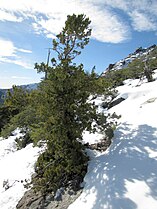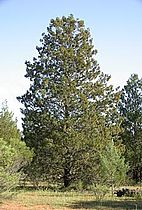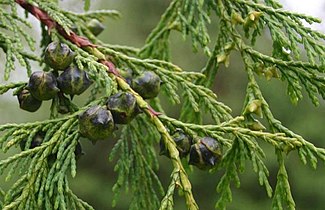Cypress: Difference between revisions
Content in this edit is translated from the existing Portuguese Wikipedia article at pt:Cipreste; see its history for attribution. Additional information added re. description and species. |
|||
| Line 1: | Line 1: | ||
{{Short description|Genus of plants in the conifer family Pinaceae}} |
{{Short description|Genus of plants in the conifer family Pinaceae}} |
||
{{other uses |
{{other uses}}{{distinguish|Cyprus}} |
||
'''Cypress''' is a common name for various [[conifer]]ous trees or shrubs from the ''[[Cupressus]]'' [[genus]] of the ''[[Cupressaceae]]'' family, typically found in [[Temperate climate|warm-temperate]] and [[Subtropics|subtropical]] regions of [[Asia]], [[Europe]], and [[North America]].<ref name=":0">{{Cite web |date=2024-03-22 |title=Cypress {{!}} Growing, Pruning & Planting Tips {{!}} Britannica |url=https://www.britannica.com/plant/cypress |access-date=2024-04-28 |website=www.britannica.com |language=en}}</ref> |
|||
| ⚫ | |||
Cypress trees are a large classification of conifers, encompassing the trees and shrubs from the cypress family (Cupressaceae) and many others with the word ''cypress'' in their common name. Many cypress trees have needle-like, evergreen foliage and acorn-like seed cones. |
|||
__TOC__ |
__TOC__ |
||
== Description == |
|||
Cypress trees typically reach heights of up to {{Convert|25|m|ft}} and exhibit a [[Pyramid|pyramidal]] form, particularly in their youth. Many are characterised by their needle-like, [[evergreen]] foliage and [[acorn]]-like seed cones. Some species develop flattened, spreading heads at maturity, while certain variants may manifest as shrubs, standing at less than {{Convert|6|m|ft}}. The [[Bark (botany)|bark]] of cypress trees varies, with some species having smooth surfaces, while most exhibit bark that separates into thin plates or strips, often shedding over time. Leaves of young cypress trees are spreading and awl-shaped, and are typically small, scale-like formations that tightly adhere to older branches. They are usually [[Aroma compound|aromatic]], with glandular pits on the outer surface, and cover the stem in opposite pairs, giving the branchlet a four-sided appearance.<ref name=":0" /> |
|||
==Species== |
==Species== |
||
Cypress is any of the twelve species of ornamental and timber [[evergreen]] conifers constituting the genus ''Cupressus'' of the family ''Cupressaceae''. Many [[Resin|resinous]], aromatic evergreen trees called cypress belong to other genera of the same family, especially species of [[false cypress]] and [[Cypress-pine|cypress pine]]. The name ''cypress'' is occasionally used for some species of [[fustic]] and for [[bald cypress]], and it often denotes [[jack pine]] in eastern [[Canada]].<ref name=":0" /> |
|||
Species that are commonly known as cypresses include: |
Species that are commonly known as cypresses include: |
||
*Cypress (multiple species within the genus '' |
*Cypress (multiple species within the genus ''Cupressus''): |
||
**''[[Cupressus sempervirens]]'', a common cypress also referred to as Italian cypress and Mediterranean cypress.<ref name=":1">{{Cite web |title=Cupressus sempervirens L. GRIN-Global |url=https://npgsweb.ars-grin.gov/gringlobal/taxon/taxonomydetail?id=12665 |access-date=2024-04-28 |website=npgsweb.ars-grin.gov}}</ref> It is native to [[Libya]], [[Cyprus]], [[Iran]], [[Israel]], [[Jordan]], [[Lebanon]], [[Syria]], [[Turkey]], and [[Greece]].<ref name=":1" /> |
|||
**''[[Hesperocyparis lusitanica]]'', commonly known as the Mexican cypress, which is native to [[Mexico]] and [[Central America]].<ref>{{Cite web |title=Cupressus lusitanica Mill. var. lusitanica GRIN-Global |url=https://npgsweb.ars-grin.gov/gringlobal/taxon/taxonomydetail?id=318471 |access-date=2024-04-28 |website=npgsweb.ars-grin.gov}}</ref> |
|||
*''[[Chamaecyparis]]:'' |
|||
**''[[Chamaecyparis lawsoniana]]'', known as the Lawson's cypress or Port Orford cedar.<ref name=":2">{{Cite web |title=Chamaecyparis lawsoniana (A. Murray bis) Parl. GRIN-Global |url=https://npgsweb.ars-grin.gov/gringlobal/taxon/taxonomydetail?id=10064 |access-date=2024-04-28 |website=npgsweb.ars-grin.gov}}</ref> This is a native species to [[Oregon]] and northwestern [[California]].<ref name=":2" /> |
|||
*''[[Taxodium]]:'' |
|||
**''[[Taxodium ascendens]]'', commonly known as pond cypress<ref>{{Cite web |title=USDA Plants Database |url=https://plants.sc.egov.usda.gov/home/plantProfile?symbol=TAAS |access-date=2024-04-28 |website=plants.sc.egov.usda.gov}}</ref> and native to North America. |
|||
**''[[Taxodium distichum]]'', commonly known as bald cypress and native to the southeastern United States.<ref>{{Cite web |title=Taxodium distichum (L |url=https://www.srs.fs.usda.gov/pubs/misc/ag_654/volume_1/taxodium/distichum.htm |access-date=2024-04-28 |website=www.srs.fs.usda.gov}}</ref> |
|||
**''[[Taxodium mucronatum]]'', commonly known as Montezuma cypress or Montezuma bald cypress.<ref name=":3">{{Cite web |title=Taxodium mucronatum Ten. GRIN-Global |url=https://npgsweb.ars-grin.gov/gringlobal/taxon/taxonomydetail?id=80068 |access-date=2024-04-28 |website=npgsweb.ars-grin.gov}}</ref> It is native Mexico, [[Guatemala]], and southern-central United States.<ref name=":3" /> |
|||
*''[[Calocedrus]]:'' |
|||
**''[[Calocedrus decurrens]],'' which has the common names bastard-cedar, incense-cedar and California incense cedar.<ref name=":4">{{Cite web |title=Calocedrus decurrens (Torr.) Florin GRIN-Global |url=https://npgsweb.ars-grin.gov/gringlobal/taxon/taxonomydetail?id=8615 |access-date=2024-04-28 |website=npgsweb.ars-grin.gov}}</ref> They are native to North America, specifically California, Oregon, [[Nevada]], and Mexico.<ref name=":4" /> |
|||
*''[[Thuja]]:'' |
|||
**''[[Platycladus|Platycladus orientalis]]'' or ''Thuja orientalis,''<ref name=":5">{{Cite web |title=Platycladus orientalis (L.) Franco GRIN-Global |url=https://npgsweb.ars-grin.gov/gringlobal/taxon/taxonomydetail?id=310211 |access-date=2024-04-28 |website=npgsweb.ars-grin.gov}}</ref> commonly known as Chinese thuja and native to [[China]] and [[Korea]].<ref name=":5" /> |
|||
*''[[Thujopsis]]:'' |
|||
**''Thujopsis dolabrata'', also known as asunaro and hiba<ref name=":6">{{Cite web |title=Thujopsis dolabrata (Thunb. ex L. f.) Siebold & Zucc. GRIN-Global |url=https://npgsweb.ars-grin.gov/gringlobal/taxon/taxonomydetail?id=36596 |access-date=2024-04-28 |website=npgsweb.ars-grin.gov}}</ref>. This is a native species of [[Japan]].<ref name=":6" /> |
|||
Other species include: |
|||
Otherwise: |
|||
{{div col|colwidth=40em}} |
{{div col|colwidth=40em}} |
||
| Line 31: | Line 50: | ||
*Western red cedar (''[[Thuja plicata]]''), native to North America. |
*Western red cedar (''[[Thuja plicata]]''), native to North America. |
||
{{div col end}} |
{{div col end}} |
||
The family [[Cupressaceae]] also contains 13–16 other genera (not listed above) that do not bear ''cypress'' in their common names. |
|||
{{center|'''Plants named cypress'''}} |
{{center|'''Plants named cypress'''}} |
||
<gallery mode="packed" widths=140px heights=140px> |
<gallery mode="packed" widths="140px" heights="140px"> |
||
File:Actinostrobos arenarius fruits murchison.JPG|'' |
File:Actinostrobos arenarius fruits murchison.JPG|''Actinostrobus arenarius'' |
||
File:Austrocedrus chilensis por pabloendemico - 001.jpg|'' |
File:Austrocedrus chilensis por pabloendemico - 001.jpg|''Austrocedrus chilensis'' |
||
File:Slender Cypress-pine.jpg|'' |
File:Slender Cypress-pine.jpg|''Callitris preissii'' |
||
File:Chamaecyparis Pisifera bonsai.JPG|''[[Chamaecyparis pisifera]]'', [[bonsai]] |
File:Chamaecyparis Pisifera bonsai.JPG|''[[Chamaecyparis pisifera]]'', [[bonsai]] |
||
File:Lone Cypress Sunset.JPG|'' |
File:Lone Cypress Sunset.JPG|''Cupressus macrocarpa'', [[Monterey Peninsula]], California |
||
File:Nootka Cypress.jpg|'' |
File:Nootka Cypress.jpg|''Cupressus nootkatensis'' |
||
File:Flickr - lo.tangelini - i.jpg|'' |
File:Flickr - lo.tangelini - i.jpg|''Cupressus sempervirens'' (Mediterranean Cypress), [[Tuscany]], [[Italy]] |
||
File:Fokienia hodginsii - Kunming Botanical Garden - DSC03140.JPG|'' |
File:Fokienia hodginsii - Kunming Botanical Garden - DSC03140.JPG|''Fokienia hodginsii'' |
||
File:Fitzroya cupressoides (da Silvio Rossi).jpg|'' |
File:Fitzroya cupressoides (da Silvio Rossi).jpg|''Fitzroya cupressoides'' |
||
File:Glyptostrobus pensilis 2007.06.28 10.10.35-p6280031.jpg|'' |
File:Glyptostrobus pensilis 2007.06.28 10.10.35-p6280031.jpg|''Glyptostrobus pensilis'' foliage |
||
File:Pilgerodendron uviferum.jpg|''[[Pilgerodendron uviferum]]'' |
File:Pilgerodendron uviferum.jpg|''[[Pilgerodendron uviferum]]'' |
||
File:Taxodium ascendens in the Black Water, Okefenokee.jpg|'' |
File:Taxodium ascendens in the Black Water, Okefenokee.jpg|''Taxodium ascendens'', [[Okefenokee Swamp]], Georgia (USA) |
||
File:Widdringtonia whytei Mulanje Malawi.jpg|''[[Widdringtonia whytei]]'', Malawi |
File:Widdringtonia whytei Mulanje Malawi.jpg|''[[Widdringtonia whytei]]'', Malawi |
||
</gallery> |
</gallery> |
||
== Etymology == |
|||
The word ''cypress'' is derived from [[Old French]] ''cipres'', which was imported from [[Latin]] ''cypressus'', the [[Latinisation (literature)|latinisation]] of the [[Greek language|Greek]] κυπάρισσος (''[[kyparissos]]'').<ref>[https://www.perseus.tufts.edu/hopper/text?doc=Perseus%3Atext%3A1999.04.0057%3Aentry%3Dkupa%2Frissos κυπάρισσος], |
|||
| ⚫ | |||
== Symbology == |
|||
In [[Greek mythology]], ''Cyparissos'', ''Cyparissus'' or ''Kyparissos'' ([[Ancient Greek]]: Κυπάρισσος, "cypress") was a male lover of [[Apollo]],<ref name=":7">{{Cite web |last=Parry |first=Katy |date=2022-01-14 |title=Cupressus sempervirens |url=https://www.chelseaphysicgarden.co.uk/cupressus-sempervirens/ |access-date=2024-04-28 |website=Chelsea Physic Garden |language=en-GB}}</ref> as well as other [[Deity|deities]] in other versions of mythology. |
|||
In the most prevalent version of the story, Cyparissus receives a [[stag]] as a gift from Apollo, which he accidentally kills with a spear while hunting in the forest. Cyparissus is overwhelmed by pain and sorrow, and asks Apollo to allow his tears to flow for eternity. Apollo transforms Cyparissus into a cypress tree, and the [[sap]] that typically drips down the tree's trunk represents Cyparissus' tears.<ref name=":7" /><ref>{{Cite web |title=CYPARISSUS (Kyparissos) - Cean Prince of Greek Mythology |url=https://www.theoi.com/Heros/Kyparissos.html |access-date=2024-04-28 |website=www.theoi.com}}</ref> |
|||
Consequently, the cypress emerged as a symbol of mourning, sadness, and loss in classical mythology, thereby serving an [[aetiological]] purpose in explaining its cultural significance.<ref name=":7" /> Due to its connection to grief, the cypress became one of the symbols of [[Hades]] and has been planted in cemeteries since the [[classical era]]. During the [[Renaissance]] period, the myth of ''Kyparissos'' was revived, and is depicted in several works of art and poetry.<ref name=":7" /> |
|||
==See also== |
==See also== |
||
Revision as of 18:47, 28 April 2024
Cypress is a common name for various coniferous trees or shrubs from the Cupressus genus of the Cupressaceae family, typically found in warm-temperate and subtropical regions of Asia, Europe, and North America.[1]
Description
Cypress trees typically reach heights of up to 25 metres (82 ft) and exhibit a pyramidal form, particularly in their youth. Many are characterised by their needle-like, evergreen foliage and acorn-like seed cones. Some species develop flattened, spreading heads at maturity, while certain variants may manifest as shrubs, standing at less than 6 metres (20 ft). The bark of cypress trees varies, with some species having smooth surfaces, while most exhibit bark that separates into thin plates or strips, often shedding over time. Leaves of young cypress trees are spreading and awl-shaped, and are typically small, scale-like formations that tightly adhere to older branches. They are usually aromatic, with glandular pits on the outer surface, and cover the stem in opposite pairs, giving the branchlet a four-sided appearance.[1]
Species
Cypress is any of the twelve species of ornamental and timber evergreen conifers constituting the genus Cupressus of the family Cupressaceae. Many resinous, aromatic evergreen trees called cypress belong to other genera of the same family, especially species of false cypress and cypress pine. The name cypress is occasionally used for some species of fustic and for bald cypress, and it often denotes jack pine in eastern Canada.[1]
Species that are commonly known as cypresses include:
- Cypress (multiple species within the genus Cupressus):
- Cupressus sempervirens, a common cypress also referred to as Italian cypress and Mediterranean cypress.[2] It is native to Libya, Cyprus, Iran, Israel, Jordan, Lebanon, Syria, Turkey, and Greece.[2]
- Hesperocyparis lusitanica, commonly known as the Mexican cypress, which is native to Mexico and Central America.[3]
- Chamaecyparis:
- Chamaecyparis lawsoniana, known as the Lawson's cypress or Port Orford cedar.[4] This is a native species to Oregon and northwestern California.[4]
- Taxodium:
- Taxodium ascendens, commonly known as pond cypress[5] and native to North America.
- Taxodium distichum, commonly known as bald cypress and native to the southeastern United States.[6]
- Taxodium mucronatum, commonly known as Montezuma cypress or Montezuma bald cypress.[7] It is native Mexico, Guatemala, and southern-central United States.[7]
- Calocedrus:
- Calocedrus decurrens, which has the common names bastard-cedar, incense-cedar and California incense cedar.[8] They are native to North America, specifically California, Oregon, Nevada, and Mexico.[8]
- Thuja:
- Platycladus orientalis or Thuja orientalis,[9] commonly known as Chinese thuja and native to China and Korea.[9]
- Thujopsis:
Other species include:
- African cypress (Widdringtonia species), native to Southern Africa[11]
- Bald, Pond, and Montezuma cypresses (Taxodium species), native to North America
- Chinese swamp cypress (Glyptostrobus pensilis), Vietnam, critically endangered[12]
- Cordilleran cypress (Austrocedrus chilensis), native to Chile and Argentina[13]
- Cypress-pines (Actinostrobus species), southwestern Australia[14]
- Cypress-pines (Callitris species), Australia and New Caledonia[15]
- False cypress (Chamaecyparis species), Asia and North America.[16]
- Fujian cypress (Fokienia hodginsii), southeastern China[17]
- Guaitecas cypress (Pilgerodendron uviferum), western Patagonia[18] and Tierra del Fuego[13]
- Japanese cypress (Chamaecyparis obtusa), East Asia
- Patagonian cypress (Fitzroya cupressoides), southern Chile and Argentina
- Mediterranean cypress (Cupressus sempervirens), famous for its longevity, popular garden plant
- Monterey cypress (Cupressus macrocarpa), native to the Monterey Peninsula, California[19]
- Nootka cypress (Cupressus nootkatensis), native to the Pacific Northwest of North America[20]
- Siberian cypress (Microbiota decussata)
- Summer cypress (Bassia scoparia), in the family Amaranthaceae
- Western red cedar (Thuja plicata), native to North America.
-
Actinostrobus arenarius
-
Austrocedrus chilensis
-
Callitris preissii
-
Cupressus macrocarpa, Monterey Peninsula, California
-
Cupressus nootkatensis
-
Fokienia hodginsii
-
Fitzroya cupressoides
-
Glyptostrobus pensilis foliage
-
Taxodium ascendens, Okefenokee Swamp, Georgia (USA)
-
Widdringtonia whytei, Malawi
Etymology
The word cypress is derived from Old French cipres, which was imported from Latin cypressus, the latinisation of the Greek κυπάρισσος (kyparissos).[21][22]
Symbology
In Greek mythology, Cyparissos, Cyparissus or Kyparissos (Ancient Greek: Κυπάρισσος, "cypress") was a male lover of Apollo,[23] as well as other deities in other versions of mythology.
In the most prevalent version of the story, Cyparissus receives a stag as a gift from Apollo, which he accidentally kills with a spear while hunting in the forest. Cyparissus is overwhelmed by pain and sorrow, and asks Apollo to allow his tears to flow for eternity. Apollo transforms Cyparissus into a cypress tree, and the sap that typically drips down the tree's trunk represents Cyparissus' tears.[23][24]
Consequently, the cypress emerged as a symbol of mourning, sadness, and loss in classical mythology, thereby serving an aetiological purpose in explaining its cultural significance.[23] Due to its connection to grief, the cypress became one of the symbols of Hades and has been planted in cemeteries since the classical era. During the Renaissance period, the myth of Kyparissos was revived, and is depicted in several works of art and poetry.[23]
See also
References
- ^ a b c "Cypress | Growing, Pruning & Planting Tips | Britannica". www.britannica.com. 2024-03-22. Retrieved 2024-04-28.
- ^ a b "Cupressus sempervirens L. GRIN-Global". npgsweb.ars-grin.gov. Retrieved 2024-04-28.
- ^ "Cupressus lusitanica Mill. var. lusitanica GRIN-Global". npgsweb.ars-grin.gov. Retrieved 2024-04-28.
- ^ a b "Chamaecyparis lawsoniana (A. Murray bis) Parl. GRIN-Global". npgsweb.ars-grin.gov. Retrieved 2024-04-28.
- ^ "USDA Plants Database". plants.sc.egov.usda.gov. Retrieved 2024-04-28.
- ^ "Taxodium distichum (L". www.srs.fs.usda.gov. Retrieved 2024-04-28.
- ^ a b "Taxodium mucronatum Ten. GRIN-Global". npgsweb.ars-grin.gov. Retrieved 2024-04-28.
- ^ a b "Calocedrus decurrens (Torr.) Florin GRIN-Global". npgsweb.ars-grin.gov. Retrieved 2024-04-28.
- ^ a b "Platycladus orientalis (L.) Franco GRIN-Global". npgsweb.ars-grin.gov. Retrieved 2024-04-28.
- ^ a b "Thujopsis dolabrata (Thunb. ex L. f.) Siebold & Zucc. GRIN-Global". npgsweb.ars-grin.gov. Retrieved 2024-04-28.
- ^ Pauw, C.A.; Linder, H.P. (1997). "Widdringtonia systematics, ecology and conservation status". Bot. J. Linn. Soc. 123: 297–319. doi:10.1111/j.1095-8339.1997.tb01421.x.
- ^ Thomas, P.; Yang, Y.; Farjon, A.; Nguyen, D. & Liao, W. (2011). "Glyptostrobus pensilis". IUCN Red List of Threatened Species. 2011: e.T32312A9695181. doi:10.2305/IUCN.UK.2011-2.RLTS.T32312A9695181.en. Retrieved 9 January 2018.
- ^ a b Farjon, A. (2005). Monograph of Cupressaceae and Sciadopitys. Royal Botanic Gardens, Kew. ISBN 1-84246-068-4.
- ^ "Actinostrobus". Flora of Australia Online. Department of the Environment and Heritage, Australian Government.
- ^ "Callitris". Kew World Checklist of Selected Plant Families.
- ^ "Chamaecyparis". Kew World Checklist of Selected Plant Families.
- ^ Thomas, P.; Yang, Y. (2013). "Chamaecyparis hodginsii". IUCN Red List of Threatened Species. 2013: e.T32351A2815809. doi:10.2305/IUCN.UK.2013-1.RLTS.T32351A2815809.en. Retrieved 12 November 2021.
- ^ Luebert, Federico; Pliscoff, Patricio (2017) [2006]. Sinopsis bioclimática y vegetacional de Chile (in Spanish) (2nd ed.). Santiago de Chile: Editorial Universitaria. pp. 192–195 and 208–209. ISBN 978-956-11-2575-9.
- ^ Hogan, C. Michael; Frankis, Michael P. (2009). "Monterey Cypress: Cupressus macrocarpa". GlobalTwitcher.com. Archived from the original on 2017-09-06. Retrieved 2017-03-17.
- ^ "Cupressus nootkatensis". PLANTS Database. United States Department of Agriculture; Natural Resources Conservation Service. 2015.
- ^ κυπάρισσος, Henry George Liddell, Robert Scott, A Greek-English Lexicon, on Perseus Digital Library
- ^ "Online Etymology Dictionary". www.etymonline.com.
- ^ a b c d Parry, Katy (2022-01-14). "Cupressus sempervirens". Chelsea Physic Garden. Retrieved 2024-04-28.
- ^ "CYPARISSUS (Kyparissos) - Cean Prince of Greek Mythology". www.theoi.com. Retrieved 2024-04-28.













